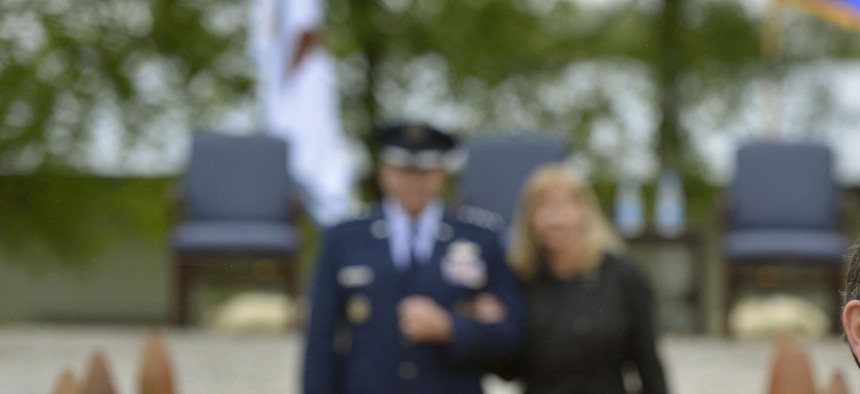
Deputy Defense Secretary Ash Carter departs after presiding over the EUCOM change of command ceremony on May 10, 2013. DoD Photo By Glenn Fawcett
Ash Carter Has One Shot To Keep the Pentagon’s Technology Edge
Carter likely has only one shot to shape the Pentagon budget entirely on his own.
If confirmed as defense secretary, Ashton Carter will need all his abundant experience to tackle the major challenges the Pentagon faces in trying to maintain America’s military edge. Indeed, Carter’s most important legacy will hinge on how much success he has in aligning the defense budget and procurement priorities to the needs of the era.
The military force the Pentagon has traditionally planned to build is not one that will keep our military supreme. Indeed, the United States is no longer the only international actor to employ stealth fighters, satellites and long-range precision-guided munitions. Dozens of countries are embracing unmanned systems and the globalization of the defense industry means that technological advances will come fast and furious even outside the U.S. If left unaddressed, these trends could mean that the U.S. may find itself outclassed in serious fights in the Western Pacific, Eastern Europe and beyond.
Carter’s top priority should therefore be on arresting the decline of America’s military technological edge. In fact, Carter’s legacy depends entirely on what he is able to accomplish this year. The president’s fiscal 2016 budget request is already in, and the 2018 budget will be submitted after the next president is elected. That means that the fiscal 2017 budget could be the only one Carter will be able to really control.
Thankfully, Carter does not need to start from scratch. Deputy Defense Secretary Robert Work has spent the last year driving the Pentagon to confront and adapt to the challenges to U.S. military superiority, and Republican defense leaders on Capitol Hill are increasingly seized with this grave problem.
Rather than reinventing the wheel, among Carter’s first steps should be to put his personal imprimatur on the Pentagon’s developing “offset strategy,” which was designed to develop ways for U.S. forces to win back advantage in a more competitive military-technological world. Carter should be particularly sympathetic to this effort, as it draws inspiration from the earlier “offset strategy” initiative of the late 1970s led by his mentor William Perry, an endeavor that spurred path-breaking advances in stealth, networking and precision navigation. Like its model, this new offset strategy hopes to leverage American and allied advantages in technology and military innovation to retain dominance in a more challenging era.
(Read more: Obama’s New Look Pentagon Trio of Carter, Work, Kendall Excites Defense Industry)
The plan needs more than just rhetorical support. Carter should personally advocate for technological capabilities that are essential for sustaining America’s military lead.
First, the Pentagon must procure a new long-range stealth bomber to replace the aging B-2 bomber fleet, which is becoming increasingly vulnerable to adversary air defenses. A penetrating bomber is vital to the conventional and nuclear strike functions that underpin American military superiority. It is critical that this new bomber is able to penetrate advanced air defense systems and effectively attack defended targets. Without it, U.S. power projection would be gravely weakened. With a decision expected in the coming months, Carter must work to build support in the Pentagon, Congress and beyond . It should not be held hostage to inter-service rivalries, short-sighted penny-pinching or self-interested attacks.
Second, Carter should put his personal weight behind an invigorated U.S. submarine building program, including conventional and nuclear-firing subs. The growing threats to America’s surface ships and short-range, non-stealthy aircraft are making U.S. undersea advantages ever more important. Yet the U.S. is sauntering at a relatively modest pace of submarine building and is set to retire its missile-carrying Ohio-class SSBNs and SSGNs in the coming years.
Beyond these traditional platforms, Carter should ensure the Pentagon doubles down and accelerate its efforts on drones, above and below the sea. Such systems will be a crucial part in sustaining American advantages in the medium to longer-term. A totemic case in point is pressing the Navy to develop an unmanned carrier-based strike aircraft that can extend the operating range of the carrier air wing. Without it, the vaunted aircraft carrier, symbol of American power and investment, risks becoming obsolete in an era of long-range precision missiles that can hunt and kill big ships. At the same time, Carter should ensure the Pentagon’s initial investments in unmanned underwater vehicles produce prototypes that can help spur the creation of entire fleets of unmanned systems that can extend the range and power of U.S. submarines. Carter should push the military services to embrace the potential of unmanned and autonomous systems to help the United States solve the increasingly vexing quandary of how to bring adequate numbers of capable forces to the battle quickly and decisively.
If Carter can leave office in 2017 with these crucial programs well on their way to development, history will applaud his tenure.



